❑Emergency Management Mode - created to comply with the Third Edition UL® 1981 Standard 6.3.4 (a-d) - may be implemented when your Central Station needs to better allocate and manage the Central Station Operator's Processing Time due to an external emergency (e.g., weather event, major power loss, flood) that is affecting the entire Central Station.
•Severe Weather and broadly based Power Outages are the two most common reasons to implement the Emergency Management Mode.
✓During these types of emergency situations, Central Stations are often flooded with Active Signals reporting various Non Life Threatening Supervised Events of low importance, but that still require a Response from an Operator.
✓Non Life Threatening Supervised Events (e.g., Low Battery, AC Loss, Failed to Open or Close, Hi Temp, Low Temp) are normally assigned a less important Priority Level (i.e., a higher Priority Number) within the Alarm Conditions Form (as illustrated below).
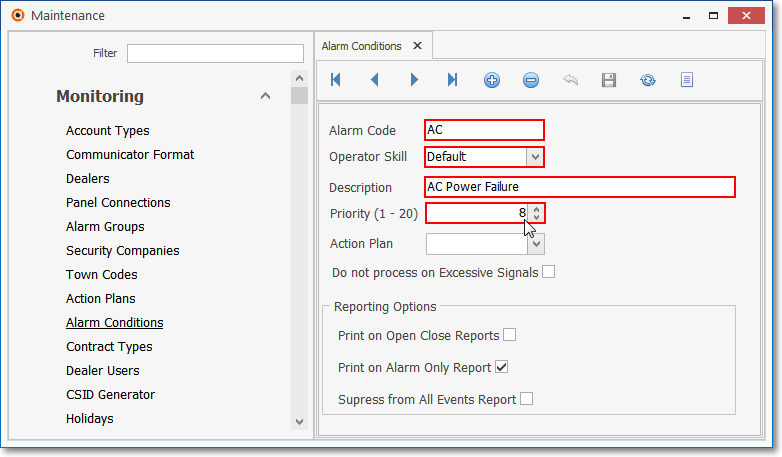
Alarm Condition Form AC Power Loss - Priority level = 8
✓Priority - The higher the Priority Number (see the mouse pointer in the illustration above), the lower its importance in relation to life safety.
▪Typically, assigning a Priority Level of 6 or higher indicates that the Alarm Condition Code is not directly related to a Life Safety related event.
•By implementing the Emergency Management Mode, all Alarm Signals (and other Supervisory Events), which have a Priority Level set at or above a specified Priority Level number, will be placed on Hold immediately.
✓While in Emergency Management Mode, those selected Active Signals are automatically placed on Hold but will still remain in the Alarm Stack .
✓As time permits, these signals may easily be retrieved and properly Processed as the Emergency abates.
•In summary, by implementing the Emergency Management Mode,
✓Your Central Station Operators will be able to concentrate and process the most important signals - those relating to life safety -
✓As the emergency situation subsides, they may retrieve the remaining signals from the Alarm Stack, where they were automatically placed on Hold by this Emergency Management Mode process.
❑To access the Emergency Management Mode dialog,
•Press Ctrl+F2, or Select the Emergency Management Mode option available as an option on the Actions Menu located on the Actions Tab
✓This action will display the Emergency Management Mode Form.
•There are two tabs on the Emergency Management Mode Form:
1.Enhanced EMM - This tab provides the Enhanced Emergency Management Mode with several options to fine-tune which Accounts are affected by the Emergency Management Mode.
2.Traditional - This tab - the original Emergency Management Mode tab - allows an Authorized Operator to Activate and Deactivate this function, as needed.
❑Understanding how to use the Emergency Management Mode dialog
•Enhanced EMM - This tab provides several options to fine-tune which Accounts are affected by the upgraded Enhanced Emergency Management Mode

Emergency Management Mode Form - Enhanced EMM tab
✓To start the Enhanced Emergency Management Mode Process:
▪Select the Enhanced EMM tab and Click the Add ("+") Icon
▪Fill in these 5 columns on the newly added row on the Enhanced EMM tab
▪When completed, this information provides the means to custom define which set of Accounts will be placed in Emergency Management Mode:
1.Type - Using the Drop-Down Selection List provided, Choose the Type of Emergency Management Mode that is to be implemented (see the "Using the various Type selection/definition dialogs" discussion below).
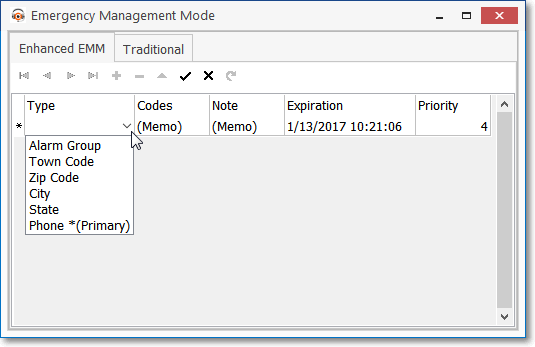
2.Codes - Click on the (Memo) field in the Codes column, then Click the Ellipse to open the appropriate selection/definition dialog.
i.Check each selection, or enter the appropriate definition data to identify which Accounts are to be placed into Emergency Management Mode.
ii.Click the OK button.
3.Note - If appropriate, Double-Click the (Memo) field in the Note column to open the Notes dialog and enter any additional information, as needed.
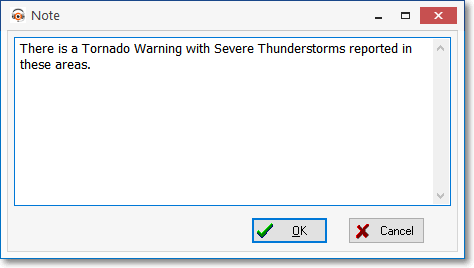
Note - Identify the reason Emergency Management Mode was started
i.Click the OK button.
4.Expiration - By default, the Expiration Date will be set as Tomorrow at this same time but may be changed using the Drop-Down Calendar/Date Entry field

5.Priority - By default, the Priority Level is set to '4' but a different Number may be entered, if appropriate.
▪Click the Save ("ü") Icon on the Enhanced EMM tab to record this Emergency Management Mode entry.
oExcept for Telephone Exchange entries [see "Phones * (Primary)" discussion below], you may update any Pending Signals in the Alarm Stack (placing those that qualify on Hold) based on their Alarm Processing Group(s) and Priority Level, if required.

▪Any number of Enhanced EMM entries may be activated at the same time.
•Using the various Type selection/definition dialogs:
✓These are the 6 Type dialogs:
a.Alarm Group - All Subscribers that are members of the Selected Alarm Group(s) will be subject to the Emergency Management Mode procedures.
i.Codes - Click on the (Memo) field in the Codes column, then Click the Ellipse to open the Select one or more alarm groups dialog.
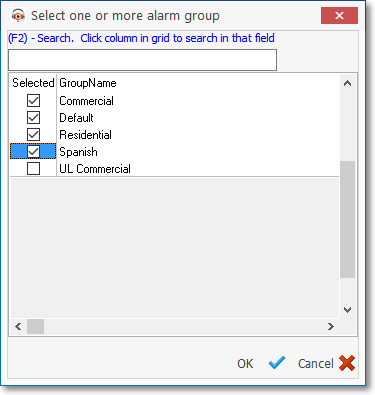
Select one or more alarm group dialog
ii.Check each of the Alarm Groups (i.e., Types of Accounts) which are to be placed into Emergency Management Mode.
b.Town Code - All Subscribers that are located within the Governmental Jurisdictions represented by the Selected Town Codes will be subject to the Emergency Management Mode procedures.
ii.Codes - Click on the (Memo) field in the Codes column, then Click the Ellipse to open the Select one or more town codes dialog.
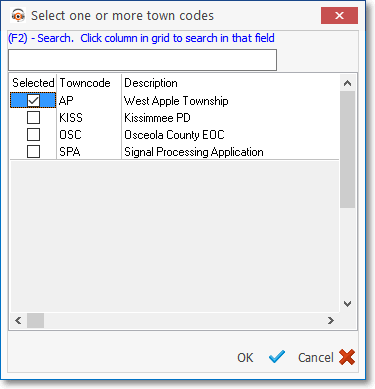
iii.Check each of the Town Codes which are to be placed into Emergency Management Mode.
c.Zip Code - All Subscribers that are located within the listed Zip Code(s) will be subject to the Emergency Management Mode procedures.
iii.Codes - Click on the (Memo) field in the Codes column, then enter each of those Zips Codes, each Zip Code entry must be separated by a comma.
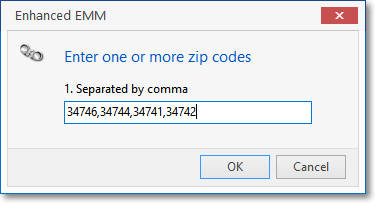
d.City - All Subscribers that are located within the listed Cities will be subject to the Emergency Management Mode procedures.
iv.Codes - Click on the (Memo) field in the Codes column, then enter each of those Cities, each City Name entry must be separated by a comma.

e.State - All Subscribers that are located within the listed States will be subject to the Emergency Management Mode procedures.
v.Codes - Click on the (Memo) field in the Codes column, then enter each of those States, each State Code entry must be separated by a comma.
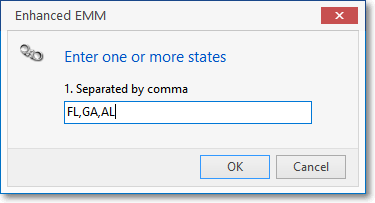
f.Phone *(Primary) - All Subscribers whose Telephone Exchange matches one of these listed Telephone Exchanges will be subject to the Emergency Management Mode procedures.
vi.Codes - Click on the (Memo) field in the Codes column, then enter each of those Telephone Exchanges, each Phone Exchange entry must be separated by a comma.
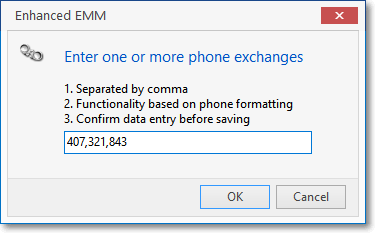
ii.Pending alarms (from the alarm stack) will not be automatically adjusted (placed on Hold).

•When the Emergency Management Mode ("EMM") is Activated, an A115 Signal is inserted into the SPA Account's Alarm History.
✓The Alarm Signal History Detail will indicate the following:
ID: 20 (System assigned record number)
Type: Alarm Group
Code: '1' (Code number is based on the Type selected above)
Expiration: 6/24/2015
Priority: 4
Note:
✓A message ("EMM ACTIVE ") is displayed at the bottom of the MKMSCS Desktop indicating the Emergency Management Mode is Active.
![]()
•When the Emergency Management Mode ("EMM") is Deactivated, an A116 Signal is inserted into the SPA Account's Alarm History.
✓The data lines below refer to the SPA Special Subscriber Account which has a Subscriber Panel record with a CSID of "SPA" and - among others - must have these EMM Activation and Deactivation Signal Identifiers defined in CSID Zones.
▪Signal ID = A115 Alarm Code = System Messages OCTAR = Alarm Description = Emergency Mode Activation
▪Signal ID = A116 Alarm Code = System Messages OCTAR = Alarm Description = Emergency Mode Deactivation
❑Traditional tab
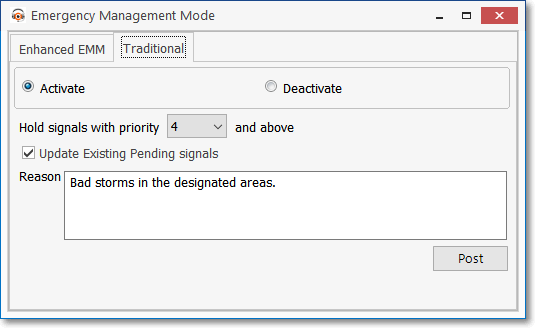
•Activate - Select the Traditional tab, and Click the Activate button - filling in the information shown below, as required.
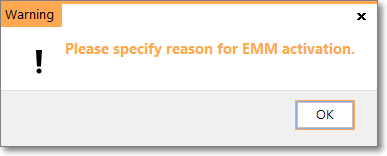
Activating Emergency Management Mode
✓Hold signals with priority nn and above - By default, the Priority Level is set to 4.
▪You may Modify this number, as appropriate.
✓Update Existing Pending signals - By default, signals already in the Alarm Stack are left unchanged.
▪Check this box to place signals in the Alarm Stack on Hold if they have a Priority at or above what you've specified above.
✓Reason - Enter a brief explanation as to why Emergency Management Mode was turned on.
▪This is a mandatory field, and if not filled in, a message will be displayed to remind the Operator to do so.

▪Click the Post button to activate the Emergency Management Mode.
✓A message ("EMM Active") is displayed at the bottom of the MKMSCS Desktop indicating the Emergency Management Mode is Active.
✓Deactivate - To turn Off the Emergency Management Mode, Press Ctrl+F2 and then Click the Deactivate button and Click the OK button.
▪So, if the Emergency Management Mode has been Activated (set to On), and you want to turn it off, Click Deactivate and Click the OK button.

The Default setting is Deactivate